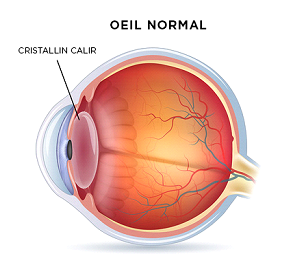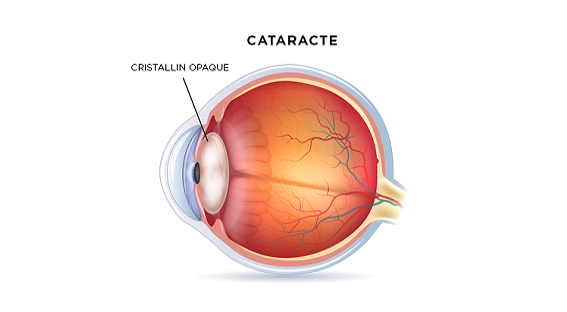What is a cataract?
A cataract usually develops with age and is manifested by the opacification of the natural lens of the visual system in the middle of the eye. This can cause blurred vision, glare, halos and/or
double vision. Cataracts often affect both eyes, but they can be asymmetrical. Progression is generally slow, but some cataracts can progress rapidly.


Why and how is a cataract surgery performed?
The primary goal of surgery is to improve vision and, in some cases, decrease dependence on glasses or other visual aids. Your ophthalmologist uses ultrasound to break the cataract
into several small pieces and sucks it out of the eye. It will then place a transparent artificial lens.

What to expect before the surgery?
Your ophthalmologist will assess your cataract and determine if it is a routine case or if there are conditions that may require additional treatment (e.g.: weakness in the lens support system,
associated glaucoma, retinal pathology, cornea). Your ophthalmologist will discuss the services offered by the Régie de l'Assurance Maladie du Québec (RAMQ) and additional uncovered services that can reduce your dependence on
glasses.
What are the options of the artificial lenses?
There are 3 main classes of lenses: monofocal, toric or multifocal.
⦁ Monofocal lenses allow you to target a single area of clear vision without visual aids,
either for near vision, intermediate vision or vision from afar. The health of the visual system must be perfect to ensure good vision in the targeted area – to be discussed with your doctor. For example, close vision allows
reading books or newspapers. Intermediate vision is useful for reading a cell phone or a computer. Vision at distance is useful for tasks such as driving or reading posters or signs. Depending on the selected target
(near, intermediate or far vision), the rest of the areas of vision will require visual aids such as glasses.
⦁ Toric lenses can also be used to target only one of the three areas of vision as mentioned above, but these types of
lenses are available to patients suffering from astigmatism. You should ask your doctor if you are candidates for toric lenses.
⦁ Multifocal lenses divide the light entering the eye into several areas of vision. Depending on
the lens selected, this option offers the best chance of having clear vision in the near, intermediate and/or far areas without visual aids. However, due to the shape of multifocal lenses, they can lead to halos and/or night glare
in nearly 10% of patients.
What to expect during and after the surgery?
The surgery is done as an outpatient day surgery (you are not hospitalized) and lasts between 15 to 30 minutes. It is usually done under
local anesthesia (eye drops) with mild sedation if necessary. A eyelid speculum is used to keep the eyelids open and prevent blinking during the procedure. Initially, the vision will be blurred after the procedure but it
improves during the first days/ weeks. Your ophthalmologist will see you the day after surgery and then after 1 month. You will have to take healing drops for 1 month after the surgery. When the drops are finished, you
can go to your optometrist and have your glasses prescription adjusted.
What are the risks?
Complications after cataract surgery are rare and most of them can be treated successfully:
⦁ Ocular dryness
⦁ Inflammation
⦁
Infection
⦁ Hemorrhage
⦁ Drooping eyelids
⦁ Retinal detachment
⦁ Glaucoma
⦁ Mismatched implanted lens power
⦁ Dislocation of the implanted lens
⦁ Opacification of the implanted lens
⦁ Loss of vision
Your
risk of complications is increased if you have other serious eye conditions or other medical conditions. Occasionally, surgery does not improve vision due to damage caused by other conditions such as glaucoma, macular degeneration,
diabetes or other medical conditions.